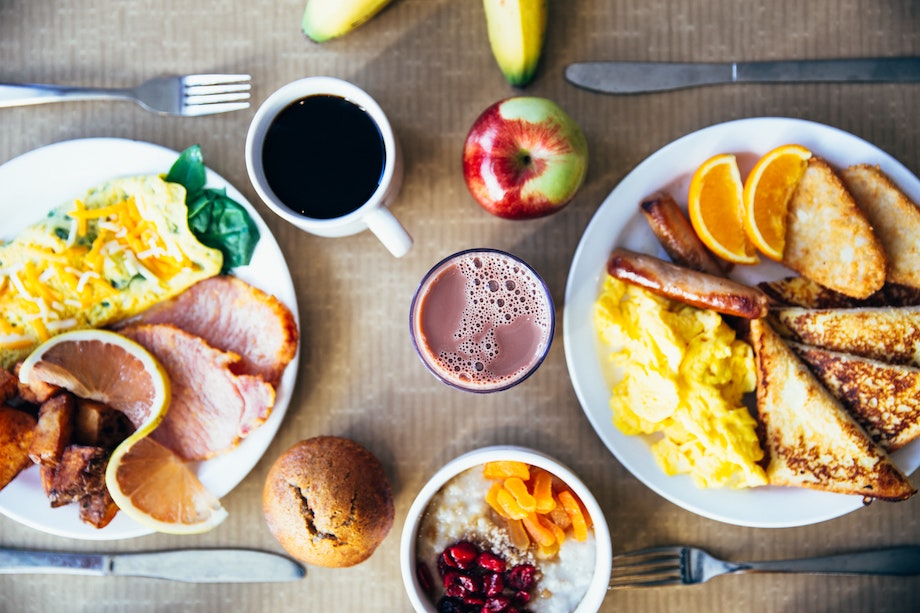We test and review fitness products based on an independent, multi-point methodology. If you use our links to purchase something, we may earn a commission. Read our disclosures.
If you’re looking to build muscle efficiently, you’re going to need to do more than just get in the gym. A large part of building muscle is diet: fueling your body to have the right balance of macronutrients required to gain muscle mass. The most important macronutrient for muscles is without a doubt protein.
Here, we’ll look at high-protein foods for muscle-building—foods packed with protein to fulfill your daily needs. I also talked with USA Weightlifting’s sports dietitian, Meagan O’Connor, RD, to get her take on which foods would prove best for building muscle.
Medical disclaimer: This article is intended for educational and informational purposes only. It is not intended as a substitute for medical advice. For health advice, contact a licensed healthcare provider.
Protein Needs for Building Muscle
Protein is the building block of muscles, and when you train, those muscle tissues can break down. In order to repair muscles adequately, we need to make sure we are supplying the cells with enough protein to balance the protein loss.
According to a review in 20191, in order to build muscle, more new muscle proteins have to be formed to outweigh the breakdown of the muscle proteins from strength training. In addition to building muscle, protein has been shown to aid in muscle recovery, according to studies2.
How much protein do I need? Reputable journals have recommended that the ideal amount of protein is 1.2 to 2.0 grams of protein per kilogram of bodyweight for muscle recovery and performance3. This amount should be enough to build more muscle proteins than you lose.
Muscle-Building Foods
Here are some foods that are great sources of protein for anyone looking to build muscle. All figures have been pulled from FoodData Central4, the official database of the USDA’s Agricultural Research Service. If you need nutrition information beyond what’s provided here, this database provides macronutrient and micronutrient information for all sorts of foods.
RELATED: High-Protein Fast Food
Animal Protein
When we think of foods for building lean muscle, our minds quickly go to meats and animal products, and for good reason. Animal proteins provide the highest content of protein per serving when compared to other foods, so they’ll help you hit your daily protein requirements for building muscle.
Plus, animal meats are complete proteins, meaning they contain all nine essential amino acids—amino acids that aren’t produced naturally by the body, and so they must be consumed through foods.
Chicken
The amount of protein you’ll get in a serving of chicken will vary depending on the cut of meat and how it’s prepared. Nevertheless, according to FoodData Central you can expect as much as 32.1 grams of protein in a 100-gram serving (about 3.5 ounces) of skinless, braised chicken breast. The whiter, leaner cuts of chicken also tend to be low-fat when compared to darker meat, like chicken thighs.
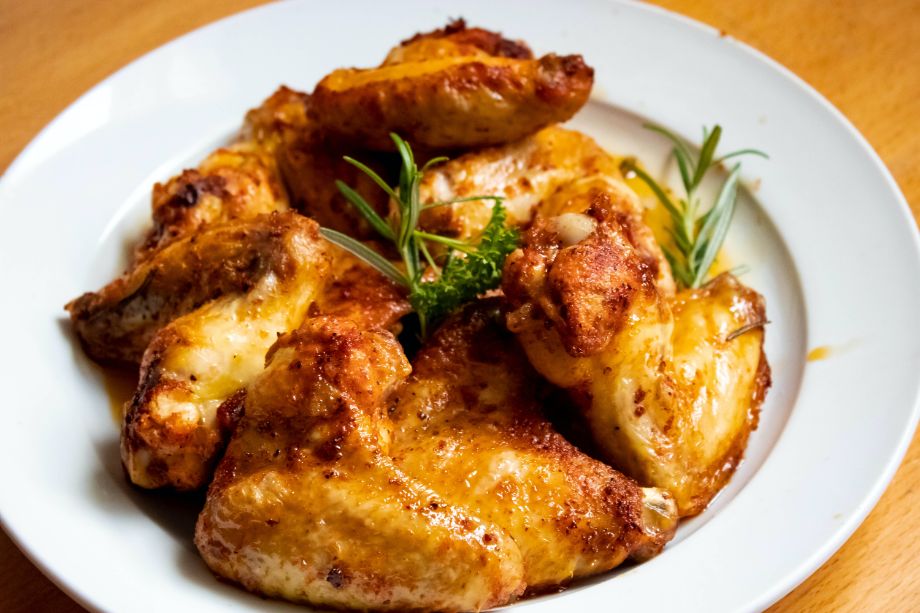
Beef
While the amount of protein varies on the cut of meat and preparation, 3.5 ounces of beef tenderloin roast will have nearly 28 grams of protein. It’s important to note that leaner cuts will have higher protein content and less saturated fat; the same goes for white meat as well.
Saturated fats have been shown to raise cholesterol levels and increase your risk of heart disease, so choosing leaner meat will reduce your saturated fat intake, while also increasing your protein intake. It’s a win-win.

Turkey
Yes, you can have turkey outside of Thanksgiving! Often used as an alternative to fattier red meats, turkey can provide a lot of protein. A pan-broiled 3.5-ounce serving of 93% lean ground turkey is packed with 27 grams of protein.
Fish
Fish is a great source of protein, but also of healthy fats. Fish can contain omega-3 fatty acids, as well as EPA and DHA. These fish oils have been shown to be vital in heart health, lowering triglycerides and improving heart function, according to this study from March of 20205.
RELATED: Best Fish Oil Supplements
There are lots of fish in the sea, and this isn’t dating advice. There are many high-protein foods form the ocean, but here are some of my favorites with a good bit of protein in them:
- Salmon: There are more than 20 grams of protein in a 3.5-ounce serving of Atlantic salmon before it’s cooked.
- Tuna: Cooked tuna can provide 28 grams of protein in 3.5 ounces, but that’s not the only way to have tuna. Meagan says, “Canned tuna in water is a secret whammy of protein,” and she’s not wrong; there are 19 grams of protein in the same serving size.
- Tilapia: Tilapia is a fantastic option as well, providing about 23 grams of protein in one filet (87 grams).

Eggs
Since the movie “Rocky,” eating raw eggs has been associated with bodybuilders and gym-goers in their strength training. I’m here to tell you though: you can cook them and still have a good source of protein. One large egg has about 6 grams of protein; additionally, they are a very versatile ingredient and can be prepared in many ways.
RELATED: How Many Grams of Protein in an Egg?
If you are eating a lot of whole eggs in your high-protein diet, you can limit your calorie and cholesterol consumption by removing the yolk on some of your eggs. The egg white is still an excellent source of protein, having more than half of the protein contained in the egg.
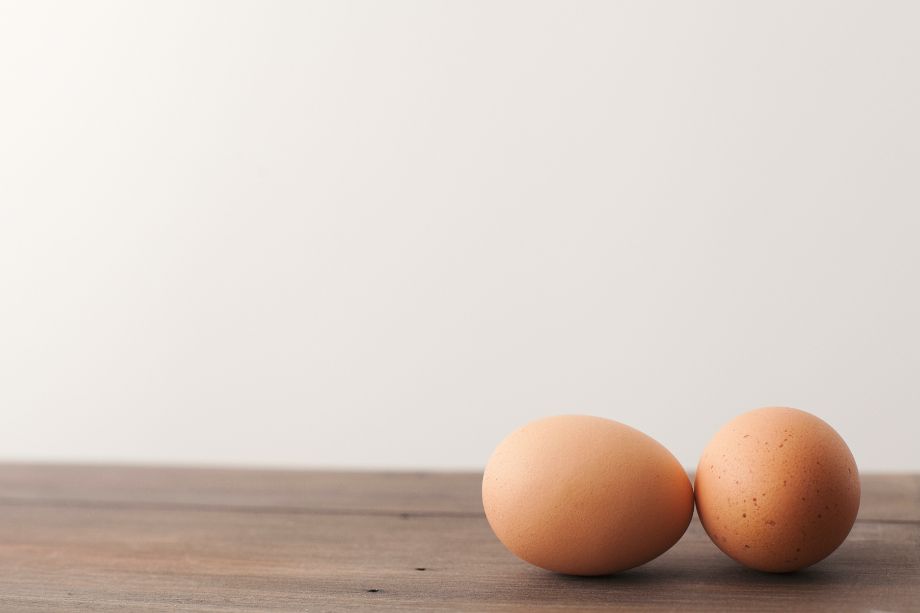
Dairy
So long as you have a tolerance to lactose, dairy can provide a good source of protein, along with the other macronutrients, carbohydrates and fats (depending on whether you’re choosing low-fat or fat-free options). Even more, dairy products are rich foods in calcium, essential for good bone health.
Milk
“G.O.M.A.D.” was a fad early in my lifting career—Gallon Of Milk A Day. It was common among weightlifters and bodybuilders in a bulking phase to commit to this principle, and to try to drink a gallon of milk in every 24-hour period. Thankfully, the fitness world, or most of it, has wised up to this silly practice.
Regardless, milk can be a great source of protein, as well as carbs, also needed for a muscle-building diet. You can add it to a protein shake for a little more protein. A cup of whole milk has 8 grams of protein, and that number rises in 2% and skim options. The same goes for carbohydrates, with 11.5 grams of carbs in whole milk, and rising to over 12 grams in skim milk.
If you’re looking for high-protein, low-carb foods for your diet, milk may not be the best option for you, but the following dairy food items may have better ratios of macronutrients suited for your needs.
Greek Yogurt
Greek Yogurt is a fantastic source of protein, plus it’s a pretty versatile food that you can add fruits, nuts, and toppings to it to change up your meal. Full-fat Greek yogurt has nearly 9 grams of protein in 3.5 ounces of yogurt, but the non-fat version has over 10 grams.
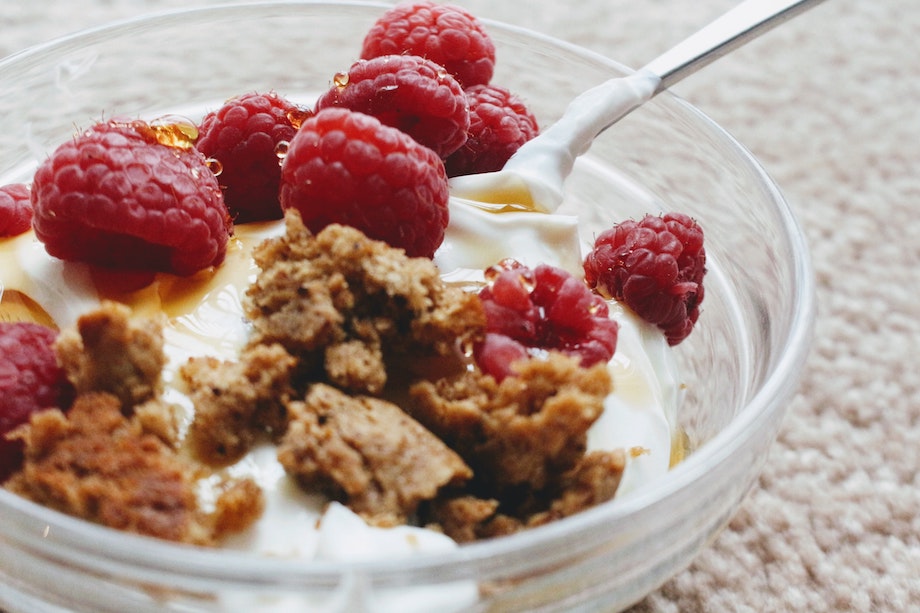
Cottage Cheese
I’ve also been recommended cottage cheese in my lifting career as a high-quality protein source for a muscle-building diet by personal trainers and coaches alike. It’s popular for having good proteins, and some, but not lots of, carbohydrates. Low-fat and full-fat cottage cheese have 11 grams and 11.6 grams of protein per 3.5 ounces, respectively. Both types will net you a little over 4 grams of carbs.
Cheese
This is a sleeping giant in high-protein foods. Quite a few cheeses are packed with protein. Here are a few examples:
- Mozzarella: Over 23 grams of protein in a 3.5-ounce serving
- Cheddar: Over 23 grams of protein in a 3.5-ounce serving
- Parmesan: Over 30 grams of protein in a 3.5-ounce serving
- Swiss: 27 grams of protein in a 3.5-ounce serving
It’s important to note that along with being great sources of protein, cheeses also tend to have a lot of fat as well. If you’re looking for high-protein, low-fat foods, you can look at low-fat or fat-free options, but you also may want to consider other foods.
Vegan and Plant-Based Protein
Although we associate many of our protein sources with animal sources, there are quite a few alternatives to animal proteins for people following vegan diets or avoiding allergies.
Tofu
Often used as a substitute for meat in cooking, tofu packs a powerful punch of protein. One half-cup serving of tofu has 10 grams of protein in it; even more impressive is that tofu is a complete protein, one of the few plant sources of protein to provide all nine essential amino acids. This is due to tofu being made from soybeans. Speaking of which…
Soybeans
As just discussed, soybeans contain all nine essential amino acids, amino acids needed in any diet, as your body doesn’t naturally produce them. Soybeans are packed with protein, as 3.5 ounces of raw soybeans has 36.5 grams of protein. That’s enough protein from a bean to take note.
Soybeans are used in a variety of plant-based protein options, including tofu, edamame, and tempeh.
Beans and Legumes
While still predominantly a source of carbohydrates, many beans and legumes provide a substantial amount of protein, as well as being a good source of the amino acid leucine, B vitamins, and magnesium. The fibers in these foods can also support gut health, according to a February study from 20236. Some common beans and legumes with protein include:
- Kidney beans: With about 25 grams of protein in 3.5 ounces of dried beans, kidney beans are one of the highest sources of protein among beans. Once cooked and with moisture though, that protein content will drop to around 8 or 9 grams.
- Lentils: Lentils are also a great source of protein, providing 9 grams of protein in 3.5 ounces of these cooked legumes.
- Chickpeas: Cooked chickpeas have 14.5 grams of protein in 8 ounces of the legume.
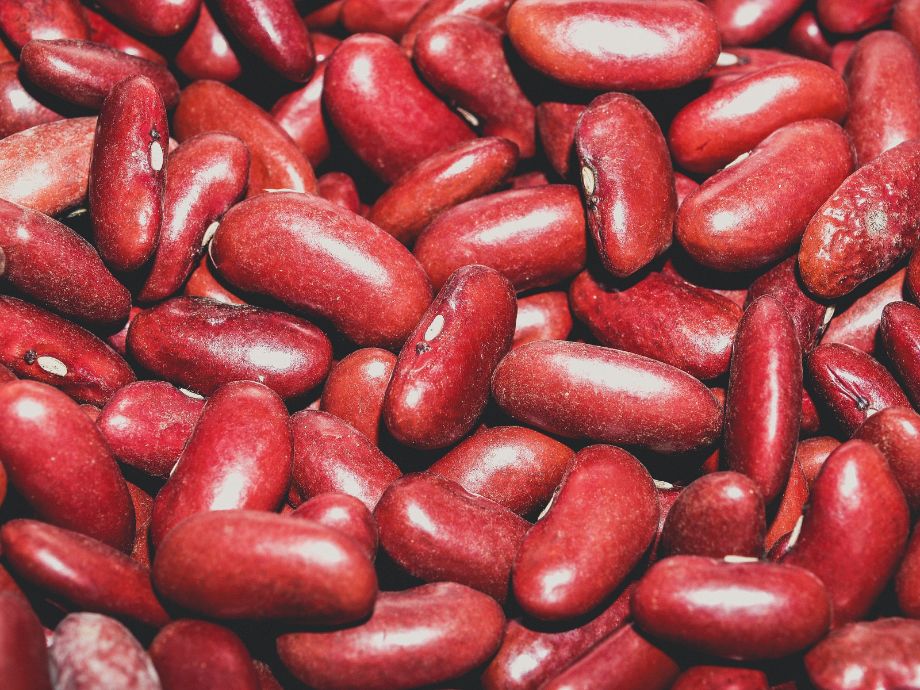
Peanut Butter
Let’s be real; peanut butter is a fat first. In a 3.5 ounce serving, you can expect over 50 grams of fats. So if you’re watching your fat intake, you may want to avoid this food.
However, peanut butter can be a good choice for a post-workout snack, as it provides a decent source of both protein and carbohydrates, ideal for recovering energy after exercising. There are 24 grams of protein per 3.5 ounces of peanut butter, with nearly 23 grams of carbs in the same amount. Almond butter is a decent alternative as well, providing almost 21 grams of protein in the same amount.
Quinoa
Although not the largest source of protein, quinoa is another unique plant-based protein in that it, like soybeans, provides all essential amino acids in one source. According to FoodData Central, quinoa provides 11.4 grams of protein in a 3.5-ounce serving.
Whole Grains
While predominantly full of carbohydrates, whole grains like oats and brown rice can provide some protein to a diet geared towards building muscle mass. Because of their carbohydrate content, they’re great to have post-workout to help replenish energy lost from a workout.
- Oats: 3.5 ounces of rolled oats can provide 13.5 grams of protein.
- Brown rice: This rice has over 7 grams of protein in 3.5 ounces uncooked.
Protein Powders
One of the most important factors in a high-protein diet is meeting your daily protein needs, and if you’re having trouble with a higher protein intake, it’s common to use the best protein powder supplements to meet your daily quota.
The most commonly used protein powder is whey protein, which is derived from milk; for muscle-building protein, whey isolate has the highest concentration of whey and has a fast absorption rate in the body, making it ideal for post-workout. The other milk-derived protein, casein, breaks down slower and is commonly taken before bed, so the protein can break down and metabolize overnight.
In addition to whey and casein protein powder, there are plant-based protein powders as well. These are great alternatives for vegans, vegetarians, or those who are lactose-intolerant.
RELATED: Plant-Based Protein Powder Benefits
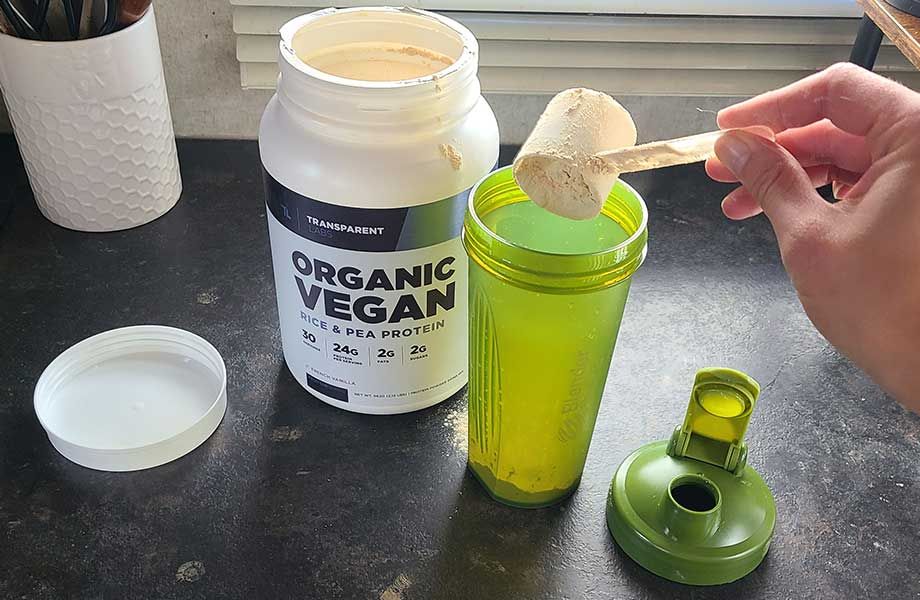
What Else Can I Do to Build Muscle?
Protein is the building block for strong muscles, but just eating protein won’t get you the most out of your high-protein diet. There are other things you should be doing to get the most out of your high-protein foods.
Exercise
Strength training is vital to building muscle and strength. Additionally, protein has been shown to help build muscle, too. According to the International Society of Sports Nutrition7, a high-protein diet does best at building muscle when combined with strength training. So make sure you’re getting out there and working out!
Sleep
If you’re not properly recovering from your workouts, you risk overtraining. One of the simplest and best ways to help with your recovery is to get proper sleep. Sleep puts the body in a state of recovery, and according to a 2017 study8, having a normal sleep routine helps recovery, as well as athletic performance.
Meagan says sleep is one of the most important things to be doing to build muscle. She notes, “Your muscles are repaired when you sleep. So is your brain, which means you can focus on your training better the next day with adequate sleep.”
Hydrate
Make sure to stay hydrated while being active. Not only can dehydration be a limiting factor in athletic performance, but a 2021 study9 shows that muscle strength and power may be negatively affected by inadequate hydration. Staying hydrated makes sure your body is ready to absorb nutrients readily and perform at its best.
High-Protein Foods For Muscle-Building: Final Thoughts
High-protein foods are great for building muscle in athletes and fitness enthusiasts alike. If your goals are to build lean body mass, high-protein foods will help with it. In order to best build muscle, Meagan recommends eating an overall healthy diet. Minimize the processed foods: “Eating high-protein foods and then a bunch of junk food won’t set you up to build muscle as nicely as high-quality foods.”
In addition to eating good, clean sources of protein, make sure to eat a caloric surplus—more calories and protein than you burn.
High-Protein Foods For Muscle-Building: Q&A
What foods are best for muscle growth?
The best foods for muscle growth are ones rich in protein, which will provide adequate energy and amino acids to repair and build muscles. Common sources of protein are animal products and meat, although some plant-based foods can provide good amounts of protein: soybeans, kidney beans, quinoa, and lentils, for example.
How much protein should I eat to build muscle?
Most studies3 suggests that eating 1.2 to 2 grams of protein per kilogram of body weight per day is ideal for muscle recovery, growth, and athletic performance.
What is the best protein powder for muscle building?
The best protein powder for muscle-building will provide a good amount of protein to help recover muscle proteins lost from exercise and activity. Check out our list of the best protein powders for muscle gain below:
Best Protein Powder for Muscle Gain Overall: Transparent Labs 100% Grass-Fed Whey Protein Isolate
Best Budget Protein Powder for Muscle Gain: Jacked Factory Authentic ISO
Best Natural Protein Powder for Muscle Gain: Legion Whey+
Best-Tasting Protein Powder for Muscle Gain: Xwerks Grow
Best Protein Powder for Muscle Gain with Unique Flavors: Kaged Re-Kaged
Best Protein Powder for Lean Muscle Gain: Ritual Essential Protein 18+
Best Grass-Fed Protein Powder for Muscle Gain: Momentous Grass-Fed Whey
Best Protein Powder for Muscle Gain Post-Workout: Garden of Life Sport Whey Protein
Best Personalized Protein Powder for Muscle Gain: Gainful
Best Hydrolyzed Protein Powder for Muscle Gain: Dymatize ISO 100
Best Casein Protein Powder for Muscle Gain: Transparent Labs Casein
Best Whey Isolate Protein Powder for Muscle Gain: 1st Phorm Phormula 1
Best Vegan Protein Powder for Muscle Gain: Vega Sport Plant Protein
These statements have not been evaluated by the Food and Drug Administration. This product is not intended to diagnose, treat, cure, or prevent any diseases.
References
- Krzysztofik M, Wilk M, Wojdała G, Gołaś A. Maximizing Muscle Hypertrophy: A Systematic Review of Advanced Resistance Training Techniques and Methods. Int J Environ Res Public Health. 2019 Dec 4;16(24):4897. doi: 10.3390/ijerph16244897. PMID: 31817252; PMCID: PMC6950543.
- Etheridge T, Philp A, Watt PW. A single protein meal increases recovery of muscle function following an acute eccentric exercise bout. Appl Physiol Nutr Metab. 2008 Jun;33(3):483-8. doi: 10.1139/H08-028. PMID: 18461101.
- Carbone JW, Pasiakos SM. Dietary Protein and Muscle Mass: Translating Science to Application and Health Benefit. Nutrients. 2019;11(5):1136. Published 2019 May 22. doi:10.3390/nu11051136
- FoodData Central; U.S. Department of Agriculture. Agricultural Research Center. Available from: https://fdc.nal.usda.gov/
- Yang ZH, Amar M, Sampson M, Courville AB, Sorokin AV, Gordon SM, Aponte AM, Stagliano M, Playford MP, Fu YP, Yang S, Mehta NN, Remaley AT. Comparison of Omega-3 Eicosapentaenoic Acid Versus Docosahexaenoic Acid-Rich Fish Oil Supplementation on Plasma Lipids and Lipoproteins in Normolipidemic Adults. Nutrients. 2020 Mar 12;12(3):749. doi: 10.3390/nu12030749. PMID: 32178279; PMCID: PMC7146314.
- Kadyan S, Park G, Singh P, Arjmandi B, Nagpal R. Prebiotic mechanisms of resistant starches from dietary beans and pulses on gut microbiome and metabolic health in a humanized murine model of aging. Front Nutr. 2023 Feb 7;10:1106463. doi: 10.3389/fnut.2023.1106463. PMID: 36824174; PMCID: PMC9941547.
- Jäger R, Kerksick CM, Campbell BI, Cribb PJ, Wells SD, Skwiat TM, Purpura M, Ziegenfuss TN, Ferrando AA, Arent SM, Smith-Ryan AE, Stout JR, Arciero PJ, Ormsbee MJ, Taylor LW, Wilborn CD, Kalman DS, Kreider RB, Willoughby DS, Hoffman JR, Krzykowski JL, Antonio J. International Society of Sports Nutrition Position Stand: protein and exercise. J Int Soc Sports Nutr. 2017 Jun 20;14:20. doi: 10.1186/s12970-017-0177-8. PMID: 28642676; PMCID: PMC5477153.
- Copenhaver EA, Diamond AB. The Value of Sleep on Athletic Performance, Injury, and Recovery in the Young Athlete. Pediatr Ann. 2017 Mar 1;46(3):e106-e111. doi: 10.3928/19382359-20170221-01. PMID: 28287684.
- Judge LW, Bellar DM, Popp JK, Craig BW, Schoeff MA, Hoover DL, Fox B, Kistler BM, Al-Nawaiseh AM. Hydration to Maximize Performance and Recovery: Knowledge, Attitudes, and Behaviors Among Collegiate Track and Field Throwers. J Hum Kinet. 2021 Jul 28;79:111-122. doi: 10.2478/hukin-2021-0065. PMID: 34400991; PMCID: PMC8336541.
Further reading

If you’re looking to build muscle efficiently, you’re going to need to do more than just get in the gym. A large part of building muscle is diet: fueling your body to have the right balance of macronutrients required to gain muscle mass. The most important macronutrient for muscles is without a doubt protein.Here, we’ll look at high-protein foods for muscle-building—foods packed with protein to fulfill your daily needs. I also talked with USA Weightlifting’s sports dietitian, » Read more about: Get Gym Gains With These High-Protein Foods For Muscle-Building » Read more

Looking to build a thicker back and bigger biceps? A personal trainer demonstrates the 9 best row exercises step-by-step, and gives sample row workouts to try. Read more

Should you bolt down your squat rack? Our personal trainer dives in to when you should, and when you may not have to. Read more

Search no longer––the team at GGR has found the best folding elliptical for you to get a killer cardio workout. Read more

